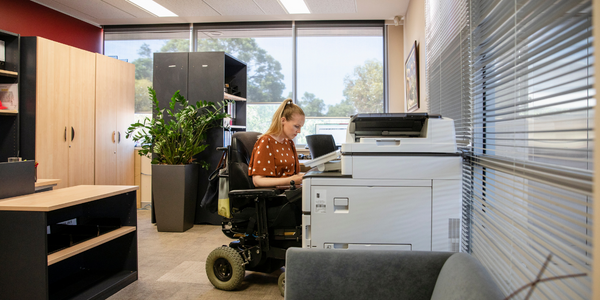What are types of assistive devices and how are they used?
Assistive devices help individuals with disabilities live a more independent life by using technology, increasing accessibility to all. A strong preventive maintenance program can ensure that these devices are operating well and providing a safe and helpful tool for their users.

Types of Assistive Technology
A wide range of assistive devices are available today to help individuals with various disabilities accomplish daily tasks more easily. Here are some examples:
Gross Motor Assistance
Mobility devices such as power wheelchairs, scooters, and prosthetic and orthotic devices help individuals with physical disabilities. In addition, building accommodations such as ramps, wide doorways, and grab bars allow people to access public facilities more easily with assistive devices.
Fine Motor Assistance
A wide range of lightweight, high-performance assistive devices allow individuals to participate in sports and physical activities. Tools such as page turners, special pencil grips, adaptive switches and utensils help with other fine motor tasks. Other specialty tools may provide assistance with tasks such as dressing, cooking and grooming.
Sight Assistance
Individuals with low vision can benefit from sight-related assistive devices. For example, bold markers, dark-lined paper, or visors can help individuals with low vision to accomplish written tasks. In addition, many magnifiers, telescopes and closed-circuit television systems are other optical devices.
Hearing Assistance
Simple devices, such as hearing aids and closed-caption technologies, can increase access to media for Deaf individuals or people with hearing loss.
Educational Devices
Many computer-based assistive devices are designed to help individuals with cognitive disabilities. For example, text-to-speech software helps students who have trouble reading, while speech-to-text aids helps those who cannot write. Voice recognition software and screen readers are other examples.

Establishing a Preventive Maintenance Program
Assistive devices and related technology is a significant investment. Whether you are using these devices in an educational setting, or as part of a business that provides disability accommodations, these devices need to be maintained for the safety and performance of those in your organization. Here are some important components of a strong preventive maintenance program to help all these devices stay operating and reliable.
Schedule Regular Maintenance
All assistive devices come with an instruction manual and care instructions. By entering this data into a computerized maintenance management system (CMMS), you can easily track and schedule all those regular maintenance tasks automatically. At scheduled intervals, your team can perform the routine cleaning, inspection, parts replacement or maintenance required to ensure your assistive devices are still safe and operational.
Easy-to-Use Work Order System
Even with a good preventive maintenance program, it’s likely that assistive devices will break or malfunction on their own. It’s important to have a streamlined and organized way of tracking the necessary repairs organization-wide. By employing a centralized system, all employees or even users can have access to the work order entry system. When they notice a needed repair, they can enter a work order. These orders can then be organized and prioritized by a maintenance manager.
Manage Replacement Parts or Disposables
A preventive maintenance program can also help an organization manage replacement parts, ordering them on demand, or ensure that disposable supplies required with devices are always well-stocked. As you accumulate historic preventive maintenance data, it will be easier to predict what you need and when you need replacement supplies.
Conclusion
Assistive devices are an amazing application of technology today. A wide range of devices increase accessibility to all through adaptations in technology. Preventive maintenance programs help keep all that technology in good working order so individuals can focus on their daily tasks at hand.
Want to keep reading?
Maintenance Manager | What Does a Maintenance Manager Do?
What are the most common maintenance requests in property management?
What Are the Most Technologically Advanced Hospitals and How Are They Taking On COVID-19?
4,000+ COMPANIES RELY ON ASSET OPERATIONS MANAGEMENT
Leading the Way to a Better Future for Maintenance and Reliability
Your asset and equipment data doesn't belong in a silo. UpKeep makes it simple to see where everything stands, all in one place. That means less guesswork and more time to focus on what matters.

![[Review Badge] Gartner Peer Insights (Dark)](https://www.datocms-assets.com/38028/1673900494-gartner-logo-dark.png?auto=compress&fm=webp&w=336)
